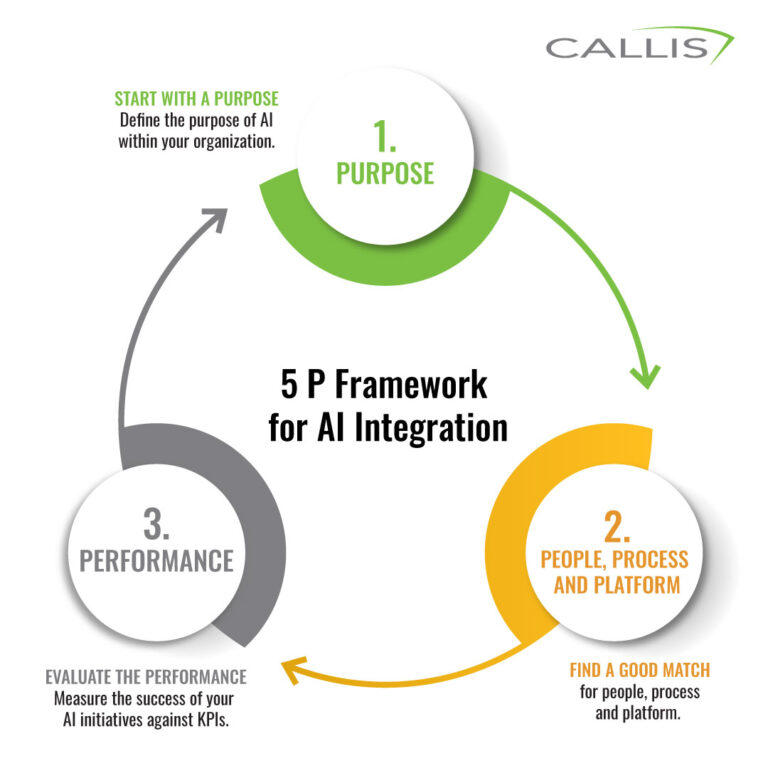Implementing AI in Your Business: A Roadmap for Success

Integrating AI into your business is not just a technological change—it’s a cultural shift. Below is a practical roadmap for businesses to successfully implement AI. This starts with the understanding that AI adoption is a long-term process that requires buy-in from leadership and a commitment to experimentation.
Creating an AI Council
Establishing an AI council is key to guiding the successful adoption and integration of AI. Whether for large organizations with cross-functional teams or smaller businesses with leaner setups, the council’s role can be tailored to fit your needs.
Every AI council should focus on two essential components:
- Implementation: Ensuring AI tools are effectively integrated into workflows and deliver measurable results.
- Policy and Direction: Setting the strategic vision for AI usage, ensuring ethical practices and creating policies that align with business goals.
If your team lacks the expertise or resources to build an AI council, or simply needs extra support, an agency or third-party partner can assist with strategy, policy creation and implementation. These partners provide the guidance needed to integrate AI successfully.
5 P Framework for AI Integration
Once an AI council is in place to guide strategy and execution, it’s important to have a clear framework for successful AI integration. The 5 P Framework offers a comprehensive approach to ensure AI is implemented thoughtfully and effectively, focusing on aligning AI initiatives with overall business goals.
- Purpose: Start by defining the purpose of AI within your organization. Whether it’s boosting revenue, improving customer satisfaction, or reducing costs, a clear purpose will guide the AI implementation process.
- People: AI is only as good as the people using it. Ensure your team is trained and that you have the right internal and external partners to support AI initiatives.
- Process: Before adopting AI, businesses should evaluate and document their current processes. This will help identify where AI can add the most value and where human intervention is still required.
- Platform: With so many AI platforms available, it’s essential to choose the right one for your business. The platform should align with your goals and processes.
- Performance: Finally, measure the success of your AI initiatives against key performance indicators (KPIs). AI should improve efficiency, drive revenue and create a measurable impact on your business.
Source: https://www.trustinsights.ai/blog/2024/04/the-5p-framework/
Critical Tips for Adopting AI Successfully
- Work with trusted partners: Collaborate with reliable partners to help identify the right AI tools and establish tailored solutions for your business.
- Early adopters set the pace: Early adopters who experiment with AI and develop a roadmap for long-term integration will be the leaders of tomorrow, setting the stage for others to follow.
- Encourage leadership experimentation: Successful AI integration requires leadership to understand AI and foster a culture of innovation.
- Prioritize people and processes over technology: AI is only as effective as the people and processes behind them. Focus on aligning your team and workflows before introducing new technology.
- Ask people what they need: Ensure that AI tools are meeting the actual needs of your employees. Success depends on whether the team adopts and effectively uses the technology.
- Invest in resources and data: AI is only as good as the data it’s fed. Invest in the necessary resources to manage data quality and ensure AI has what it needs to perform optimally. Partnering with agencies or third-party experts is a great option to access the data and resources that your business may not currently have, allowing you to leverage AI more effectively.
- Focus on education and training: Lack of training, fear and poor reasoning are common hurdles to AI success. Addressing these human challenges is crucial for successful implementation.
- New technology rarely solves old problems: Remember, AI isn’t a quick fix for longstanding issues. It’s a tool for innovation, but the underlying problems must still be addressed.
“We succeed because we fail and we’re not afraid of failure. It’s just part of our scar tissue and what has built us into who we are today. If we are not failing, we are not trying big enough things.” – Jesse Cole
Explore More AI Topics
Ready to explore how AI can enhance your business? Review more of our articles on AI or contact us to discuss the opportunities AI can bring to your marketing and operations.

